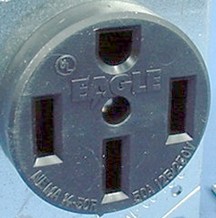xylhim said:
So I'm well aware of the differences between EVSE charging and using a DCFS system, I've read plenty of your posts in the past and am well informed :lol: ; I know that I cannot put more than 240v/15 amps into my onboard charger. That's not my question. My question is if it is possible to transform the AC to DC via an external charger (like mimicking a DCFS station) but do it at a lower voltage/amperage than a typical fast charging station. I'm not concerned about cost, this is a hypothetical; has anyone to your knowledge tried this using ChaDeMo?
Well, ABB has some 20 kW DC FCs. Fuji has some 25 kW ones. That's "lower than typical" to me, since I've only personally used 44 kW http://nissanqc.com/ ones.
I recall that valerun has been working on a cheap CHAdeMO DC FC. Below should be the right thread and is part of an email I sent to a friend of mine in Feb 2014:
-- begin email --
I haven't followed this closely as I don't care, but I only recently became aware of such projects going on due to these posts:
http://www.mynissanleaf.com/viewtopic.php?p=354329#p354329 and
http://www.mynissanleaf.com/viewtopic.php?p=354392#p354392.
His link is bad but he's apparently pointing to the thread at http://www.mynissanleaf.com/viewtopic.php?f=44&t=13349.
There's a test at http://www.mynissanleaf.com/viewtopic.php?p=349058#p349058.
I saw some pics at https://www.facebook.com/groups/BayLeafs/permalink/634786449912353/?stream_ref=2 (not sure if you can get to them). I didn't attend that meeting but there's finally a video up of it. If you're curious about it, go to http://www.youtube.com/watch?v=RW9GEm2iqr4&feature=youtu.be and skip to ~56:30, I believe the speaker is valerun on MNL.
He mentions he was quoted $2200/piece for a CHAdeMO connector, in quantities of 100. So, they 3D printed their own! There are some pics at the above FB page...
-- end email --
Maybe skip start about 10 or 20 pages from the end of that thread and read the responses valerun, if you want to know more. I'd imagine he could adapt what he's got to charge CCS cars but he needs talk Green PHY instead of CAN and deal w/any other quirks, besides having enough interest from buyers to make it worth his while. At this point, seems highly unlikely given the # cumulative # of Leafs sold vs. CCS compatible cars.
I can't speak to your 200 volts that you observed. When I've charged my Leaf on CHAdeMO DC FCs that show voltage and amperage, voltage is always near 400 volts but amperage falls as the battery gets closer to full. Eventually, if it gets full enough, it'll be below L2 speeds (below 6.6 kW).


